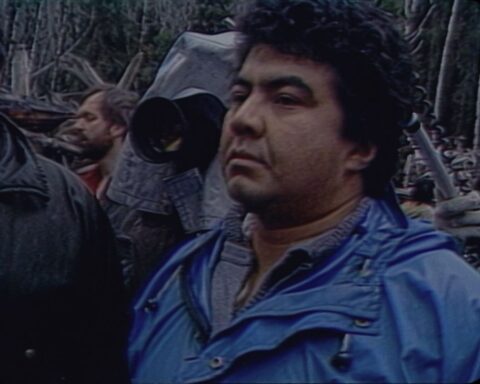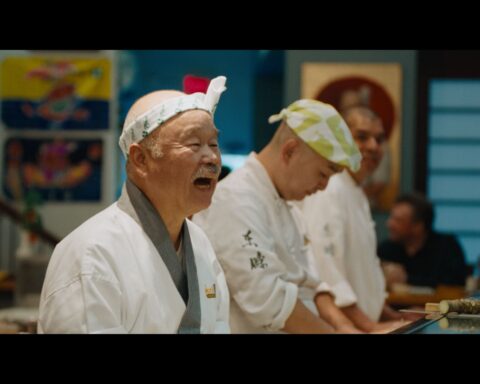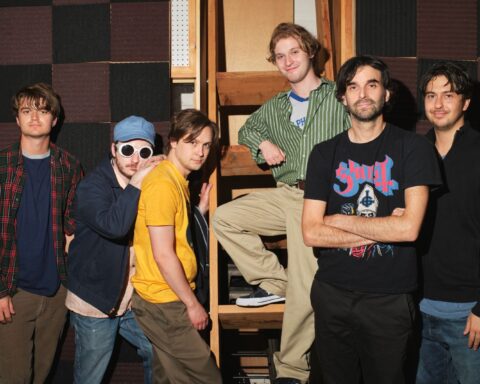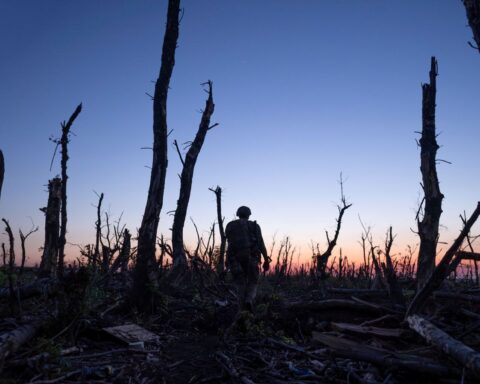VIFF 2007 had exceptional films and strong programming. It was without a doubt the best year I have ever attended in terms of the quality of documentaries screened, yet here’s a critique: the festival had little to no satellite art/cinema events or shows, and no reach, no formal means to bring the issues of these works into the larger realm of Vancouver’s social, political or cultural dis- course. It’s a lost opportunity as Vancouver is undergoing radical and global mutation the pace of which is swamping the need for all manner of public reflection. Despite the picture postcards from the chamber of commerce, the day is grey. The ecology of a Greenpeace Vancouver tide is long out; in its place is rampant developer-driven growth and increasing homelessness.
Could it be that the very model of a film festival needs reconsidering? That if in fact we are serious about addressing the problems that are presented in many of these documentaries, we need to reboot and reformat many of our cultural and social forms including how we ‘do’ a film festival?
Challenging times, though, are clearly good times for the documentary, and VIFF has birthed itself an identity on the world festivals map as a distinctly eco-aware affair and a documentary friendly event. The festival, which ran from September 17th through October 12th, screened over 90 documentary feature works to an en- thusiastic and attentive audience looking to understand our rapidly shifting world.
The Kyoto Planet Climate for Change Award is a new annual environmental film series and includes a $25,000 juried award. Surprisingly smart, the nominations for this award can include fiction as well as non-fiction films. The list of films this year included the North American pre- miere of long time experimentalists James Benning— casting a glance and Canadian Mark Leiren-Young’s quasi documentary The Green Chain.
Oddly unintegrated with the rest of the festival, an IMAX retrospective1 was the other new series at VIFF. IMAX big, ok, sensational, yes, cinema on steroids, the Hummer of the film set, definitely. 3D Dinosaurs to scare the kiddies and an immersive experience. Before there was virtual reality, there was IMAX, and before there was IMAX, there was Expo’67 in Montreal. It was the cinematic experiments of that utopian year that inspired Canadian technicians and artists to create IMAX.
The first IMAX film was Tiger Child by Donald Brittain. Clocking in at 18 minutes this quintessential and still extraordinary film demonstrates the potential of the technology. Before it became mostly sensationalism and highly controlled and choreographed (and mostly funded by corporate overseers2 ), Canadians Donald Brittain and Graeme Ferguson (North of Superior) were shooting IMAX as lightly as if they were shooting with an Aaton 16mm. The immediacy of their footage shot by a massive camera still breathes from the screen as in the instantaneous scene of a running of the rapids in a canoe and the tumbling into the river; it holds one, after forty years.
In Tiger Child , which presents a kaleid- oscopic portrait of peoples and world cultures, Brittain divides the screens in many quadrants at times, contrasting and mirroring the diversity of the world: the overview is exceedingly emotive as well as finely rhetorical.
The clarity of the images makes them appear iconographic. There’s a sense that the image floats on top of the screen, in its own fullness, and you feel closer to the world, much more so than the surface shadow of usual cinema. IMAX, when handled by masters such as Brittain, is a neglected branch of a visionary cinema
All festivals are retrospectives; each successive film is plastered, compared and thought of in terms of every other piece seen at the event. It was thus an exquisite experience to watch Bruce McDonald’s The Tracey Fragments soon after seeing Tiger Child. McDonald’s work is extraordinarily brave and essential; it’s rare that we see the recuperation of complexity and modernism in a cinema that reaches into the contemporary main- stream. McDonald’s consummate use of fragments within fragments, frames within frames, and a sort of dramatic editing omniscience marks the work as the authoritative example of the dramatic and —notably for documentary filmmakers—the particular rhetorical promise of the technique: truth realized by showing multiple viewpoints in the same time frame.
*Manda Bala (Send a Bullet)*
Grand Jury Winner Sundance prize for Documentary
Debut feature by Jason Kohn, a one-time assistant to Errol Morris 85 minutes
“When mankind becomes ruled by terror then is the hour for the mastery of crime.” —Fritz Lang, Das Testament DesDr. Mabuse, 1933
Fear dominates our social and political consciousness. It is an angst-based economy that we live under, and a culture of fear is the basic feed of our media. Chronic selfishness, addiction, and the ascendance of adolescent behaviour as a cultural norm blooms from this underlying angst and dislocation.
The bullet spins out the barrel at an ever-increasing speed.
20 million people in Sao Paulo, the largest frog farm in the world, corrosive corruption, biting off of ears and the reconstruction of ears, buying bullet proof Porsches and Mercedes—that’s Brazil, a nation that has the widest income gap in South America, with over 20 percent of its citizens living on less than two dollars a day. (Did I say the largest frog farm in the world, squirming cannibalistic amphibians in precise Morrisian, widescreen, colour-thick; film still beats video by mega-bounds splendor?)
Manda Bala is an oblique investigative web show- ing us the realities and effects of ethical collapse that is Brazil. Here disaster capitalism has morphed into terror capitalism: lumpen proletariats are running on intoxicated, rabid, guilt-free violence, which burgeoned from an atmosphere of “no way out.” Where eating the rich is not a spray-painted slogan but a way to survive. Sao Paulo—where there is a kidnapping every three days, where the rich fly from roof top to roof top via the world’s largest private helicopter fleet in an attempt to live in an emerald city of protective privilege amidst skin- hanging-from-bones misery.
The destitute are the disposable.
Manda Bala (Send a Bullet) does just that. It’s a multi-dimensional picture bulletin of a sociological/ economic state of absurd disparities3 between rich and poor—the frantic population boom and the fantasia of official and pseudo-democratic venality powered by a brutality that is a herald of trauma everywhere to come.
*The Trap: What Happened to Our Dream of Freedom*
(Originally titled: Cold Cold Heart)
Dir: Adam Curtis 108 minutes
Prod. Co.: BBC
Human beings will always betray you.
The compilation chronicle film essay is alive and well-written in the juggling, conceptual mindscape of Adam Curtis. The Trap , a three-hour-long presentation, is fixated upon a historically defining moment of today: a recollection and psychic inscription of the Cold War paranoid strategies of game theorist John Nash (made famous by a Nobel Prize and the Ron Howard Oscar winning bio-pic A Beautiful Mind). Curtis argues, not completely convincingly, that our narcissistic, atomistic, and lonely era originates from “rational choice theory,” a way of predicting the behaviour of humans promulgated by Nash, the famous mathematician—and certified paranoid schizophrenic. The premise of rational choice theory is that people are the shrewdest schemers of their own destiny, and that is their sole raison d’etre.
Through a series of sociological markers and ideological shifts, the theory became a pillar of liberal democratic thought and the focus of the ever-narrowing gaze of government purpose—the sole raison d’etat becomes the animation of isolated deterministic individualists.
“So Long Sucker—Fuck Your Buddy”, a game invented by Nash in which the only way to win was to betray your playing partners, is the title of the first part of this tripartite film, and should give you an idea as to Curtis’ theme. (If not, I don’t really give a damn as I have already been paid for this article.)
It’s a harsh, suspicious world with nary a hope for any manner of Grace, as all actions are calculations whose sum can only result in ever increasing exile and alienation.
Irresponsible economic freedom equates to com- munity degeneration, and the degradation of the commons. What is owned exists but the individual human does not: he is, bottom line, a waste product of the system.
Despite the diversions and entertainments to the contrary we are a society at war and of war; the trick is to be consciousof our militarized identities.
In the last third of the film Curtis turns to the work of Isaiah Berlin arguing that his refocusing on “negative liberty” as the best of all possible political worlds is a predictive for a nihilist and authoritarian regime populated by selfish automatons. The liberty to do as one pleases as the primary agenda in all the arenas of life is shown to be a pathetic dumbing down of what it means to be a human. Negative liberty is in the end, too often, infantilism. Positive Freedom, Positive Liberty, (though historically marred by Jacobinism) is our recognition of our common humanity. It is the vehicle of fulfillment, not through the gimcracks of possessions nor social standing but through our service to one another. Curtis suggests that it is not what we take from the social but our contribution to society that answers our need for freedom. Freedom, then, is just another word for the development of shared meaning.
Curtis builds his documentary via an engaging montage punctuated by assertive constructivist graphics. His work demonstrates the efficacy of an intellectual cinema without compromise and he does this by the fluidity of his conceptualization —employing imagistic and conceptual leaps and convergences. Montage as rendered here should not be translated as editing, or simply cutting, but as assemblage: as in the fitting together of parts in a machine. The machine is the spatio-temporal unfolding of the essential premise of the film. The Trap is a long overdue, highly associative dissection of the modern Western state and the gross deficiencies of our social (dis)order. Necessary.
Timber Gang (Mu Bang)
Dir: Yu Guangyi
Print: FanHall Studio 90 minutes
Bare bones documentary–no fluff, no music, no narration, no po-mo ironic twists, no condescending moral tales. Here, the documentary is stripped bare, renewed to illumination, time and humanity. Struggle and symbiosis of human, animal, the land, an intimacy of relationship in life and to conclusion, death. Timber Gang (Mu Bang) is a North American documentary premiere at VIFF in its prestigious “Dragons and Tigers” series of Asian-Pacific films.
Yu Guangyi is in his forties. This is his first film. He is from the region where he shot the video, Heilongjiang (part of the former Manchuria, now Northeast China) in the Changbai Mountains. It is winter and a small group of men and horses make up the team that will be working throughout the winter cutting trees and moving them down the mountain.The timber is dragged and slid through the snow bound trails by ponies and through difficult to maneuver sections by the grunt of the men. Heroes of the story, the long suffering horses, listen and obey the men with astonishing dignified acceptance. The roundness of the days is shown to us in luminously authentic images: the camaraderie between men, between the men and their horses, between the men and the mountain itself.
Though life is exceedingly demanding, these in- dividuals manage to express in sometimes comedic, and othertimes intelligent and solemn terms, the totality of their life experience. There is too much to do and too strong of a community to be ravaged by such things as alienation and depression. We are witness to a culture alive to its traditions, from shamanistic healings to a conclusive solidarity of the so symbolic funeral rites.
Rightly considered as one of the best docu- mentaries ever made in China, the film took a year and a half to edit, but does not show itself at all driven by story. Take note producer types and com- missioning editor jobber execs parroting the “story über alles” line: we don’t go to the movies for stories, we go to see movies to see movies.
*casting a glance*
James Benning,
Calarts/Film 80 minutes
James Benning, the US artist filmmaker and a long time favorite of Vancouver’s experimental and art cinema community, returned to Vancouver with the North American premiere of casting a glance, a cinematic consideration of Robert Smithson’s legendary earthwork, the Spiral Jetty , which is ‘housed’ on the banks of Utah’s Great Salt Lake.
Both art works, the Spiral Jetty and casting a glance , are simple and singular. Much of the subject for both is the weathering nature of time. Benning’s strategy in this 80 minute film is to return again and again, over a period of decades, to the site and frame his camera at identical positions for a series of 20 to 40 second clips. The result is anything but likely.
Meaningful, complete empty Zen, the film is as full as any sky or a silver cloud Eucharist. Here the sky stains the water, where knowing becomes the unknown.
This is roll on the floor, madly in love with, obses- sional, loving, devoted, patient, insightful and, for some audience members, crazy, untenable cinema. casting a glance is pure intentionality; calmly, it faces down the fidgets of entertainment. The film documents a visio-philosophical engagement, a rift in time to the complexity and varieties of individual perspicacity. Its way of seeing is so transparent and steady that it looks through the veil of appearances to the code of vision itself. A relief of distance that completes itself in the attentive viewer.
casting a glance presents a thoroughly deter- mined look, which is unforced, plain, yet eminently watchable. To perceive time both through the totality of a 30-second take and the marking of decades is liberating and exalting. Liberating, as time is not hurried and compressed with address and authorial impressions. Exalting, as time becomes unaccounted as the image becomes transcendent by and in itself.
The picture frame is tuned to repetitive positions —time, weather, light—that supply, as they did for Monet, a fortune of differences in the way light is. The erosion of the artwork and the shore and the utter morphic quality of ocean and sky be- come our wholly standing ground. Elation and the ecstatic is the call and response as the ephemeral and the eternal wave together in utter form.
Looking forward
A film festival is the occasion for community self- reflection and needs an everyday presence and an everyday community wide engagement. Clearly Vancouver has the tools and systems in place to do this. Instead of modeling the festival on competitions, votings, and prizes, we could model it on collaborations, community, talent and film development (local, national, global). There are dozens of media groups in Vancouver who could contribute to making the festival more of an agency of commission, a democratic engagement, and that would foster an authentic climate of change, one that would have a greater impact than giving a prize to a Swedish Film Institute film or giving money to a National Film Board (NFB) production via an NFB award.
What can be done? For an example of cross fertilizations and community collusion check out IDFA 2007 site http://www.idfa.nl/. Not by any means perfect, but an improvement…
Film festivals, especially ones with such a socially conscious basis as the VIFF present an orchestration of ideas. It is in the multiple ways of seeing, under- standing and acting, that we can live and participate consummately in our changing community in the chaos of the present.











